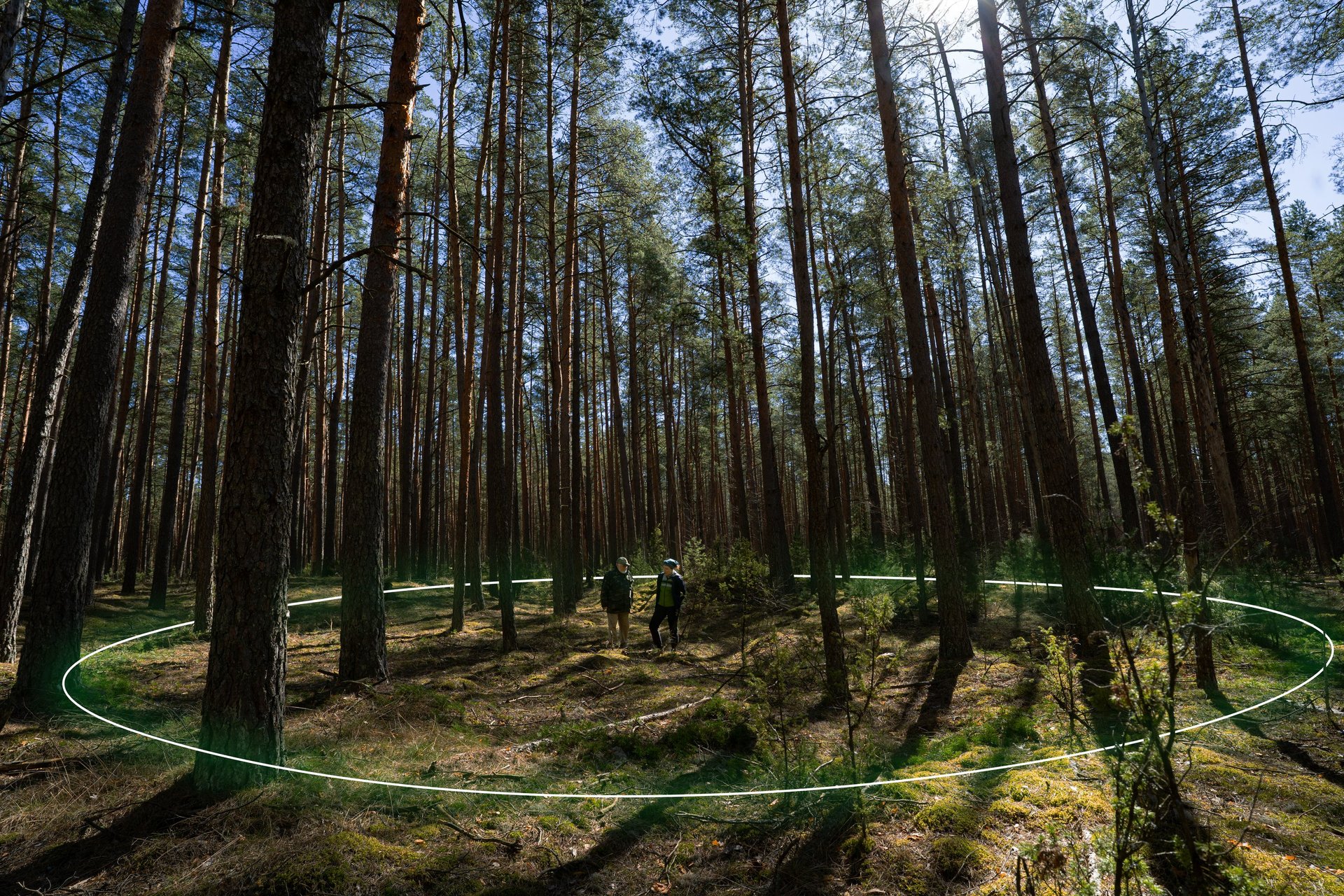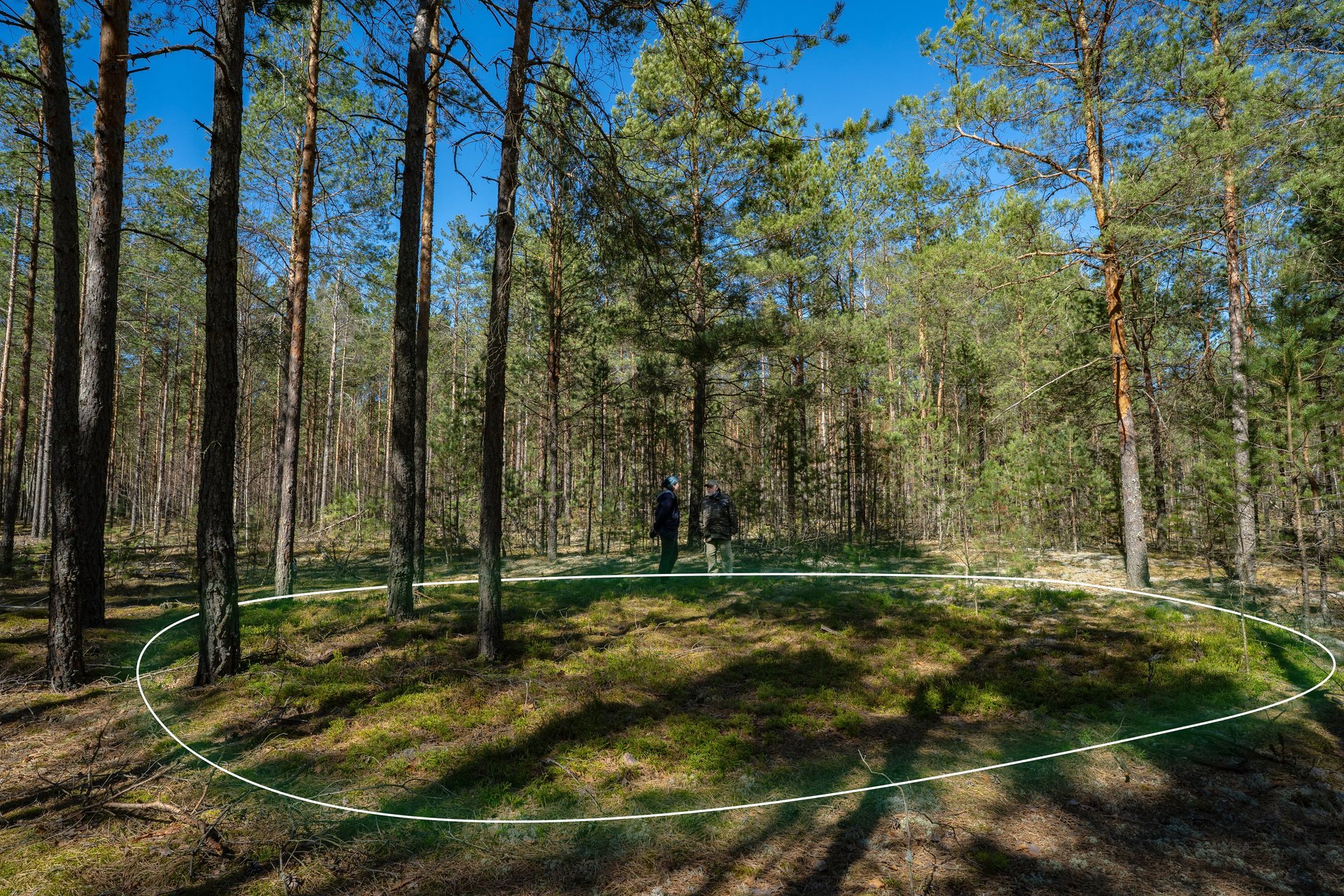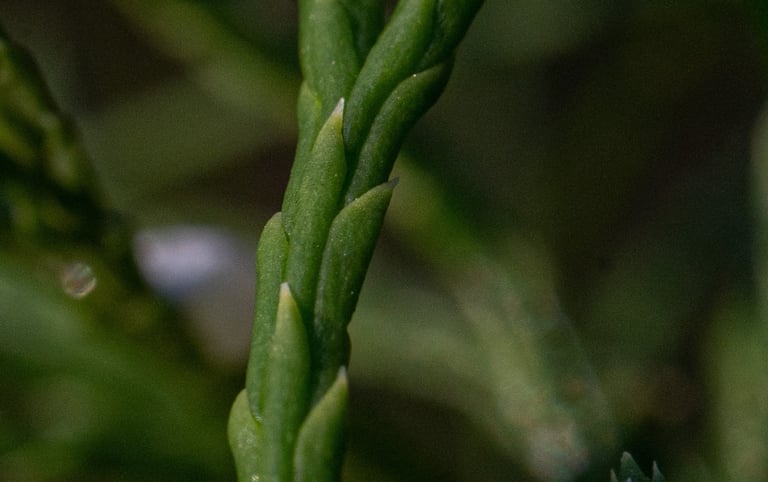IN WONDER WE FIND PEACE
In Lithuania, there is a special place, a small town called Senoji Varėna, nestled within a pine forest. In the past, there were probably no clear boundaries between the residents and the forest. We came to meet someone shaped by this place, a lifelong local, botanist, Jonas Remigijus Naujalis.
- We wanted to know what stories or legends, if any, have been told about clubmoss.
- I won't tell you any of them. Because there weren't any. - Jonas replied.
For the past year, we’ve been searching for ways to bring the life of clubmoss to light. The more we learn about them, the more we realize how remarkable and important they are, yet, paradoxically, they remain so invisible. Maybe even anonymous.
- Forty years ago, when I started studying them, there was merely nothing about them. Even in Europe, clubmoss hasn't been researched. - continued Jonas. He was the first to study clubmoss and lay the groundwork for its research in Lithuania.
It's challenging to comprehend how plants of such evolutionary significance have been overlooked.
- Well, that’s because it's believed clubmosses don’t hold any economic value.
How much remains unknown simply because we assume it holds no value? That’s why fundamental botany, in Lithuania and likely much of the world, remains underfunded. It’s often overlooked for seeking what appears to be of no immediate use. But in truth, funding botany is investing in wonder, in the long work of understanding life itself. Learning how other life forms navigate existence. A source of awe. And perhaps, in paying attention to these lives, we might begin to expand our sense of what peaceful coexistence might require.
Following Jonas Naujalis to encounter with ground cedar fairy rings - a phenomenon that was one of the key sparks behind his and his colleague's decision to start their research.
For someone like Jonas, born and raised in Senoji Varėna, the forest is a place of wonder. You never know who you’ll meet: a grass snake, a king bolete, or the silent trace of a mass grave. The forest remembers. It holds the marks of turbulent times. The Balts were among the last in Europe to be baptized into Christianity. But for us, forests remained as spaces in between - mediators between life and death, humans and gods. Even today, in a world shaped by post-humanist thinking, a quiet unease grows with each tree felled. The forest has always been where we turned for peace: for shelter, for defense. But who will protect it for those still to come?

Botanists Jonas Remigijus Naujalis and Radvilė Rimgailė-Voicik stand at the center of a ground cedar fairy ring, possibly around 100 years old. Encountering a ground cedar, or any clubmoss, is a sign of a healthy forest. This large fairy ring is a rare phenomenon, as it requires a highly specific habitat. What if the ground cedars are signaling, “This is a thriving forest, please protect it”? Perhaps ground cedar is a political actor calling for more peace in the woods? ↑
Radvilė-Rimgailė Voicik has been researching clubmosses for over a decade. Many of the locations where she once collected samples for her doctoral research no longer exist; there are clear-cut forests.
Ground cedar ↓

A smaller ground cedar fairy ring. The center is still filled with ground cedar meaning fairies haven't danced through it yet. ↓

The almost half a billion-year-old creatures saw the world crumbling apart and reassembling itself countless times. What if we try to give voice to clubmoss, telling their story through the lens of the elementals? What might we learn by exploring how they’ve endured and adapted, moving in rhythm with the forces of change and regeneration?
Fire
Disturbance, flammable spores, coal, dragons
As anonymous actors, clubmosses are not entangled in Lithuanian folklore. Maybe because the mighty dragons were not supposed to live in Lithuanian continental dunes? Clubmosses only grow up to 20 centimetres tall, but they do have a unique dragon-like quality. The spores of the lycophytes are explosive. The brief bright flame known as “witch meal” or “dragon's breath”.
Studies showed that the fire decreases the germination time from 9 months to 3 weeks after being subjected to fire. The landscape of Varėna Region has been strongly shaped by both human and naturally induced fires for millennia. Today environmentalists are using an imitation of spontaneous fires, called prescribed burning. Clubmoss desperately need fire to sexually propagate, they enjoy new opportunities emerging after forest floor fire. Probably it reminds them of the first steps in terra firma. Not to mention those arable lines between forest blocks or electricity lines. They are great to find a chance to start over again.
Clubmosses have a political statement to make on behalf of Lepidodendrons (ancient relatives): No more coal burning. It's disrespectful to our cousins Lepidodendrons! They were the giants of our kind, rising to forty meters high and soon falling into the bogs and becoming fossils. Fossils, reminding people that giant serpents are lurking deep down in the Earth, in long forgotten caves. Why are they sleeping there? Who turned them into stone? Have they damned human race with never ending greed, causing social inequality, moral corruption and finally wars? Coal gave us the Industrial Revolution. The urbanization. Electric power. The long lost treasure was released in the form of CO2, air pollution and environmental degradation. Maybe clubmoss phoenix of Lithuanian forests could offer any advice or, at least, comfort to those, seeing the great societal collapse?
Prescribed burning in newly exposed continental dunes. Clubmoss emergence could be expected in the future.
Spores out for new opportunities.
Earth
Innovations, roots, reproduction, underground relationships
The highest diversity of clubmosses is related to glaciofluvial plains, formed during the last glaciation, around 14 thousand years ago, in the southeastern part of Lithuania. The soil here is often dry, poor sandy soil, not suitable for high yield agriculture. One can grow not a vegetable garden, but a pine plantation. People used to grow buckwheat and wander in the forests collecting mushrooms and berries. For many years, the open sand continental dunes were the source of sand particles in their clothes, food, and ears. Naujalis remembers when people decided to get rid of the sand inconvenience. To stop forever moving sand with the roots of Scots pine trees. Pines, together with other naked seed gymnosperms, were the first to develop the ability to conquer harsh dry environments. It is believed that these plants were the first to climb the mountains and dominate other places with desert like conditions. Have you seen a pine in a raised bog? Tiny, but strong, floating in a cloud of sphagnum moss. The water is there, but not the nitrogen.
Interestingly, pines are always accompanied by mosses and… clubmosses. Complex interactions between fungi and plants from distant phylogenetic lineages in natural environments remain understudied, and the true nature of these relationships is not known. One could speculate that the conversations among roots and fungi hyphae are rich and sometimes overwhelming. Probably, the language used is signs of concentration change. While mosses do not have true roots, clubmoss roots are an example of remarkable conservatism. Clubmoss were the first to invent true roots, and this invention was good enough for them to succeed through hundreds of millions of years. More than 400 mln. years ago, clubmoss roots met a roommate - a fungus, willing to coexist. The relationship became so close that the sexual reproduction of these plants became impossible without the fungi. These plants grow vegetatively, spread the spores, and wait. Not for a clear cut. For spores to enter the soil and germinate. And then the game starts. Gametophyte cells are wrestling with soil fungus. Both are dividing and growing. Versatile weapons developed. Anteridia and archegonia. Will the love strike hard enough? And then a new sporophyte emerges. Small and insecure. Not photosynthesizing. Feeding on his mother's tissues, drinking through the fungus, and suffocating under the moss layer. Persistence is a key to success. After a few years, the growing shoot is stronger and able to photosynthesize.


Radvilė investigates the roots of ground pines (Diphasiastrum) to study their mycorrhizal connections with pines and blueberries.
Gametophytes remain among the least studied botanical wonders in the world
Water
Swimming sperms, dampness
Life on Earth first emerged and became extremely diverse in a primal soup, as Darwin suggested. In the ocean. When the time was right to survive on land, the innovation to keep the water within the tissues was highly needed. The mosses were not good at that. But the clubmosses got it right. The evergreen sporophytes of clubmosses are not that dependent on water. In the Tropics, there are a lot of clubmoss epiphytes, able to survive using the water that flows down the tree trunks during the rain or even gather it from the air. In deserts, people noticed a strange plant, that could dry out and then be revived; they called it the Rose of Jericho or Resurrection Plant. This plant is also a clubmoss. And we could look for another distant relative living submerged in the clean lakes - quilwort. Probably, forest clubmosses feel like them when the snow covers them up. The wind can not find them. Everything is slow and peaceful. When the ground cedar is dreaming, he definitely can feel a little spider tickling. And there is something else in the snow. Not a fish. He can hear it. He can smell it. When the early evening darkness comes, the weight of snow is remarkable.
Probably the trickiest and the most important water for clubmosses lies as a thin layer around soil particles. The capillary water is held in place by capillary forces – the combination of water’s adhesion to soil particles and its surface tension. Gravitational water moves freely through the soil due to the force of gravity and drains quickly through the large pores after heavy rain. It is believed that this water is an important medium for clubmoss sperm to swim from antheridia to archegonia. Similar to the sexual life of mosses, lycophytes get sexual only in a damp environment. The sign for the travel destination is marked with a feminine fragrance, but the true travel distance and success rate are not yet determined. Which type of soil water is the right one, though?
Stiff clubmoss nearby a little river.
Stiff clubmosses are evergreens, enduring winter in kinship with snow.
Air
Leaves, fairy rings, above ground relationships
Ancient clubmosses played a key role in creating an oxygen-rich atmosphere.
Clubmosses, as well as other plants, are building their own bodies from the air. They are locking in the carbon, which comes through the tiny plant noses - stomata. If you take a closer look you might get lost in myriads of leaves arranged perfectly on their shoots. Why are they repeating themselves? Microphyll by microphyll in this spiral pattern. It’s the ultimate, perfect angle, following the Fibonacci sequence. It reminds of rosary beads in the rough hand of the centenarian. Meditating on the events in the life of Jesus, referred to as the four mysteries. What are the four pillars of your meditation journey, clubmoss? Are you guided by the wind, water, pulse of the earth, and heat of the sun? This helical phyllotaxy starts at the tip of the shoot with a single initial cell, unlike seed plants. It is a perfect ancient performance. A meditative dance, or even a song. Do we know how these cells learn all the moves so perfectly? Is it a bioelectrical map that the cells follow in morphospace (as postulated by Michael Levin) to solve the quest for peace?
Ground cedar leaves
Mats of stiff clubmosses support other beings in shaping their worlds.


